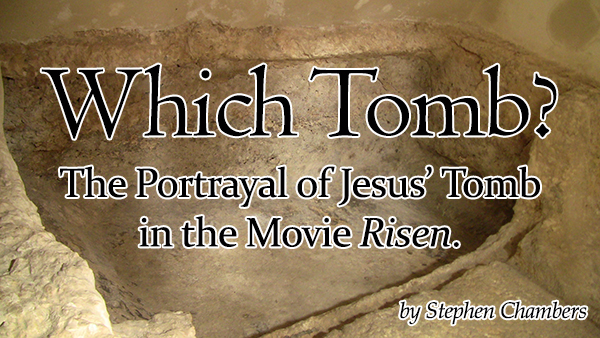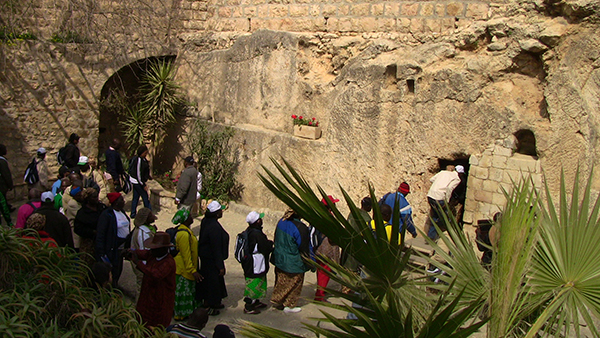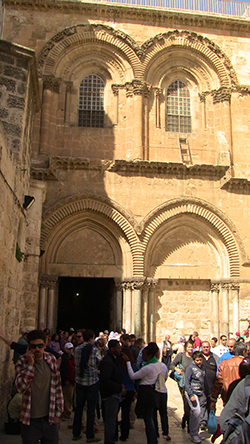Which Tomb? The Portrayal of Jesus’ Tomb in the Movie Risen

by Stephen Chambers
Many thanks to Rev. Ted Giese for his recent and very helpful review of Risen. He characterizes the movie’s main points fairly and well, rightly noting that it’s one of the best “Jesus movies.” The movie coheres very well the Gospel accounts, demonstrating a healthy respect for the reality and meaning of Jesus’ death and resurrection.
When it comes to the historical realities of first century Palestine the situation is more mixed. Many of the actors, especially among the disciples, are far too European in appearance. The landscape isn’t quite right either, as anybody who’s familiar with Israel will recognize. However, considering the movie was filmed in Spain using mostly American actors, both of these problems are understandable. And even when such details are obviously wrong—as, for instance, in the movie’s closing scenes showing Jesus and the disciples around the Sea of Galilee—the overall feel is pretty good. The producers have clearly made a significant effort toward getting the historical details right.
There’s one particular detail though that very easily could have been right but isn’t. The tomb that Jesus is shown to have been buried is not at all the sort of tomb most common in the first century A.D. There are plenty of those rather small, cramped, inter-connected tombs around, including half a dozen great examples within the Church of the Holy Sepulchre. Scholars agree that this building, parts of which date back to the fourth century AD, has a strong claim of marking the spot where Jesus was crucified and buried.
Instead, the movie shows Jesus being buried in a much bigger grave, which is immediately recognizable to knowledgeable viewers as the one known today as “The Garden Tomb.” This site was promoted as an alternative location for Jesus’ burial by a British general, Charles Gordon, after he spent several months in Jerusalem in 1883. In the movie, a huge stone is rolled into place along a groove in the bedrock in order to seal a full-height, rectangular door-opening that leads into Jesus’ grave, which is a separate construction unconnected to any of the neighbouring tombs. All of those cinematic details match The Garden Tomb perfectly.

African pilgrims visit the Garden Tomb in Jerusalem.
Unfortunately, the Garden Tomb is implausible, archaeologically speaking, as a location for Jesus’ burial. Its size, shape, and location are far too old to be the “new tomb” that the Gospels describes Jesus being buried in—a grave in which “no-one had yet been laid” (Matt 27:60, Luke 23:53; John 19:41). In fact, the Garden Tomb lies within an extensive complex of very old graves that date back to the 8th/7th century B.C. All of them are individual structures, rectangular in shape, with large openings, just like the film shows. But no graves of this type are datable to the first century A.D. To the contrary, all of the graves in Jerusalem that date from Jesus’ time are small, low, horizontal shafts that radiate from a central entry-chamber like fingers on a hand—including the graves that are still visible in the Church of the Holy Sepulchre, just metres away from the place where Jesus’ burial has been officially commemorated since the fourth century.
The Garden Tomb is implausible, archaeologically speaking, as a location for Jesus’ burial. Its size, shape, and location are far too old to be the “new tomb” that the Gospels describes Jesus being buried in.

Crowds gather at the entrance of the Church of the Holy Sepulchre in Jerusalem.
Granted, the stones that sealed this more archaeologically plausible type of grave are much smaller than the monstrous one that’s shown in the movie—which in turn matches the stone that’s on display today as a “prop” at the Garden Tomb. But even the smaller, plug-like stones that sealed actual first-century graves are big enough to qualify as the sort of “very large stone” the New Testament describes (Mark 16:4). And on the positive side, it certainly fits much better with the Gospel accounts to picture Peter “stooping down” to look into the smaller kind of tomb found at the Church of the Holy Sepulchre than into the large, full-height Garden Tomb (John 20:5).
So why did the producers of Risen choose to show Jesus being buried in a place that looks suspiciously like the Garden Tomb, even though there’s a very strong archaeological argument against it? I’m guessing it’s because the film’s target audience is mostly Evangelicals, many of whom prefer—for emotional reasons, not necessarily historical ones—the beauty and relative tranquility of The Garden Tomb, over the gritty and run-down atmosphere of the Church of the Holy Sepulchre.
Many prefer—for emotional reasons, not necessarily historical ones—the beauty and relative tranquility of The Garden Tomb, over the gritty and run-down atmosphere of the Church of the Holy Sepulchre.
Already more than a century ago, the pioneering archaeologist R.A.S. Macalister noted this same dynamic at play. In a 1907 issue of Palestine Exploration Quarterly, he commented: “In conversation with tourists at the hotel in Jerusalem I constantly hear such a remark as this: ‘I came to Jerusalem fully convinced that the Church of the Holy Sepulchre was the true site; but I went to the Church and saw all the “mummery” that goes on there, and I saw the Muhammadan soldiers guarding the place to prevent the Christians fighting. Then I went to that peaceful garden: and then I knew that the Church was wrong, and that [General] Gordon had found the real site.’ This is the most convincing argument that can be advanced in favor of the tomb [that is, The Garden Tomb], and it is obviously quite unanswerable.” Not much has changed in the last century!
Ultimately, of course, it’s impossible to know exactly what Jesus’ tomb looked like. But from an archaeological perspective, the most important details the Gospels tell us about it are that it was a new tomb in which no-one had previously been buried. Unfortunately, both of those details completely undercut the plausibility of the Garden Tomb—and thus also the location shown in Risen as the place where Jesus was buried.
———————
Rev. Dr. Stephen L. Chambers is Professor of Exegetical Theology and Academic Dean at Concordia Lutheran Seminary in Edmonton.



